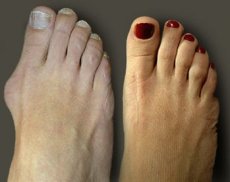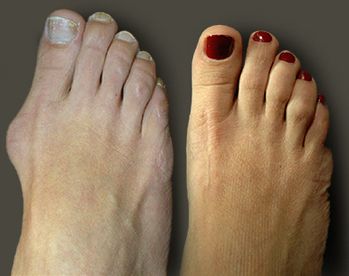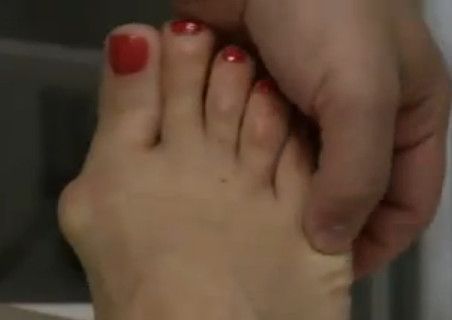Medical expert of the article
New publications
Bones on the feet: peculiarities of surgical intervention
Last reviewed: 06.07.2025

All iLive content is medically reviewed or fact checked to ensure as much factual accuracy as possible.
We have strict sourcing guidelines and only link to reputable media sites, academic research institutions and, whenever possible, medically peer reviewed studies. Note that the numbers in parentheses ([1], [2], etc.) are clickable links to these studies.
If you feel that any of our content is inaccurate, out-of-date, or otherwise questionable, please select it and press Ctrl + Enter.

Often, when the moment of non-surgical treatment of bunions on the legs has already been missed, for the sake of the beauty of the legs, women decide on surgical intervention. And then the bunions on the legs are removed by surgery. Which of them is better to do and what are the consequences of this method of treatment?

Bunions: The Essence of the Phenomenon
Bunions are not a disease, but only a manifestation of it. The disease itself is called "hallux valgus". Its symptoms are corns, calluses on the foot (but these are side effects), and the main and most striking symptom is a clearly visible and very painful bone on the big toe or, as it is also called, a bump on the foot.
The diseased joint turns red, shines, swells, and becomes hard to the touch. The bone on the foot is so painful that it is impossible to put on your usual shoes, and it is also painful to move without them. The reason for this deviation is the deformation of the metatarsal bone, which causes the head of the bone to deviate outward, and this looks like a bone.
Start of treatment
If the bones on the feet appeared not so long ago, do not hurt much, they can still be treated with non-surgical methods. These are complex methods: physiotherapy, special exercises, foot massage, the use of orthopedic devices - insoles, inserts between the toes, special orthopedic insoles.
By the way, such insoles can be made to order for you in just 20 minutes, and this is a very good way to alleviate the symptoms of bunions. This can be done on the recommendation of an orthopedist in an orthopedic clinic. If these methods no longer help, the pain becomes terrible, and going out in normal shoes is not possible, then surgery is needed.
Do they break bones in the leg during surgery?
Modern medical methods do not involve breaking bones in the leg during surgery. A few decades ago, the method of cutting the bone was used. Then they were put in the correct position and fixed with metal implants.
These could be spokes, screws, metal plates.
In order for the leg to heal properly, it was put in a cast. A scary prospect! And quite painful. Moreover, both legs were not operated on at the same time. They were operated on one at a time. Therefore, the rehabilitation period was very long. In addition, the person walked on crutches the entire time the bones were healing. It took from one and a half to two months to recover – the patient did not part with crutches during this time.
But that's not all - to restore the function of the legs, it was also necessary to undergo complex treatment methods. Plus remove the spoke or screw from the leg. This was no longer as painful, but again required time for recovery.
Surgical intervention using modern methods is much less traumatic. It does not break the bone in two, and the operation is performed on both legs at the same time, saving a lot of time and health for the patient.
 [ 4 ]
[ 4 ]
How does modern surgery work?

It is quick and almost painless. The foot being operated on is anesthetized under local anesthesia. Then the doctor corrects all the "ingredients" of the foot: ligaments, tendons, muscles, capsules. But just as a correct foot is made from cubes, the position of the toes is made correct, corrected and fixed in this form. Then the doctor puts stitches on the operated feet. They do not remain on the legs for long, the stitches can be removed after 4-5 days.
The rehabilitation period is quite short: you can already step on your heel the next day after the operation, and after the stitches are removed, you can stand on your entire foot. Your feet need to be accustomed to the load gradually, increasing it a little each day.
The legs can normally perform their functions (of course, not excessively) already a week or two after the surgery. And they will become completely stronger and fully restore their role a month or a month and a half after the surgeon's table. Then you can wear high-heeled shoes and go to parties.
The second option for performing surgery using modern methods
An incision is made in the area of the bump (bone). A small one, only 3 centimeters long. Through it, the doctor moves the tendon in the right direction, and also forms the arch of the foot - transverse. Thus, the doctor corrects flat feet, and the toes are aligned. The bump disappears from these manipulations, and no bone fractures are needed. With this method, no crutches or plaster are needed, the foot is restored very quickly in just 2-3 weeks.
If the case with the bone is really bad, you will have to do an osteotomy, that is, excision of the bone. But there is good news: they are fixed not with a steel pin, but with small screws that remain in the leg.
There is no need to perform a second operation to remove them, as this will not injure the foot again. This means that the rehabilitation period is still much shorter than with old methods of surgical intervention - from one to two months. The stitches are removed, of course, not as quickly as without excision of the bone, but you still have to wait a short time - up to two weeks.
Efficiency of surgical methods

Statistics show that surgical methods of treating bunions show excellent results in 90% of patients. If a person follows all the doctor's instructions, does not put extra strain on his legs, eats properly (and in some cases is prescribed a diet), then there is a very high probability that the operation will go without complications.
Are there any contraindications to surgery for elderly patients?
Yes, such contraindications exist. If the bones and joints of the legs are severely deformed and inflamed, it is necessary to first remove the inflammatory process, and then make decisions on surgical intervention. In addition, an elderly patient may have diseases that cause poor blood clotting or tissue dysfunction. Then the operation will most likely be canceled. The doctor will recommend non-surgical methods of influencing the bones of the big toe.

